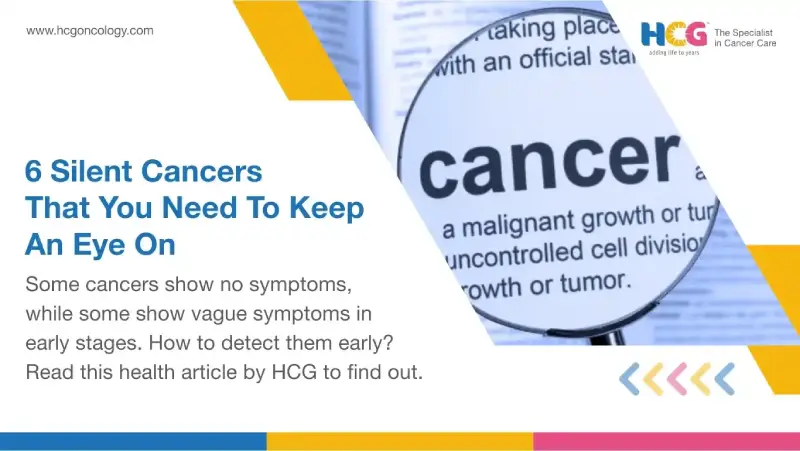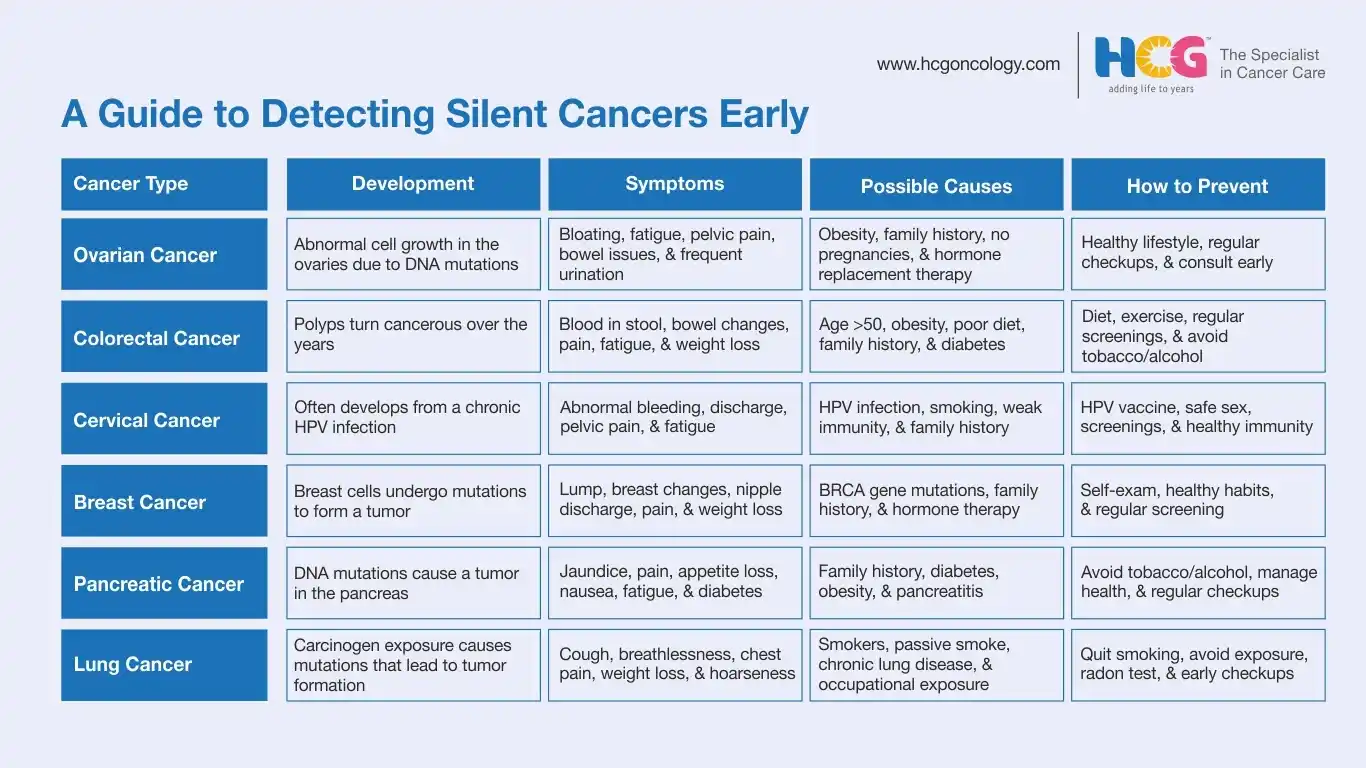
20 Nov, 2025
Feel free to reach out to us.

20 Nov, 2025

This article is medically reviewed by Dr. Tirathram Kaushik, Senior Consultant - GI, HPB, Gynecological & Thoracic Oncosurgery and Robotic Surgery, HCG Cancer Centre, Borivali.
Silent cancers refer to those cancer types that do not have any noticeable early symptoms, and in such cases, patients may have no symptoms of cancer until the advanced stages.
The doctor diagnoses silent cancers, usually in their advanced stages. However, in some cases, these cancers are detected during the diagnosis of other conditions (incidental diagnosis). Therefore, high-risk individuals must consider regular screening, which aids in the early detection of various cancer types.
The most common silent cancers include breast cancer, ovarian cancer, colorectal cancer, pancreatic cancer, and lung cancer.
In some cases, individuals with cancer show no symptoms. This is usually the case with cancers arising from internal organs, where cancerous changes occurring are not easily noticeable. This, however, does not mean that these cancers do not show any symptoms at all.
Patients with silent cancers do experience symptoms; nonetheless, they are vague and often overlap with the symptoms of several less-serious conditions. Paying attention to persistent symptoms, even if they are vague, and seeing a doctor for a prompt evaluation can aid in early detection and timely treatment.

There are several cancers that do not show symptoms until they have progressed into advanced stages. The key to early detection of these cancers lies in learning about different symptoms associated with these silent cancers and paying attention to them when they become persistent.
The following are the top 6 silent cancers:
An important silent cancer, ovarian cancer is often not diagnosed until it reaches advanced stages. The early signs of ovarian cancer are misinterpreted as symptoms of gastrointestinal problems or age-related health problems.
When the cells present in the ovarian lining undergo mutations, it may lead to precancerous changes, which will eventually lead to the formation of an abnormal cell mass, or tumor, and this is how ovarian cancer develops.
In the early stages, the mass or tumor is localized and confined to the ovaries only. However, as the disease advances, it spreads to nearby lymph nodes and different organs in the body.
Additional Reading: Ovarian Cancer vs Ovarian Cyst: Symptoms, Types, and Diagnosis
The following are the commonly observed silent symptoms of ovarian cancer:
You may consider opting for appropriate ovarian cancer prevention measures that bring down your ovarian cancer risk. Healthy food habits, regular exercise, optimum weight management, and regular health checkups are a few measures that can help you reduce your ovarian cancer risk.
If you are experiencing ovarian cancer symptoms, do not ignore them. These symptoms are often persistent and do not go away even after taking medication.
Consult your doctor and explain your symptoms to them in detail. They may ask you to undergo specific tests. If the observations from these tests are alarming, you may be asked to consult a specialist for a conclusive diagnosis and appropriate medical interventions.
Ovarian cancer is associated with various risk factors, and individuals with these risk factors fall under the “high-risk” category.
The different risk factors identified for ovarian cancer include obesity, certain inherited genetic mutations, a history of endometriosis, a family history of ovarian cancer, early menstruation, late menopause, absence of pregnancy, and hormone replacement therapy.
Colorectal cancers are also considered silent, as they often do not exhibit any symptoms in their early stages. Colorectal cancer is one of the top ten cancers in India, and it is diagnosed more often in men than in women. The risk of developing colorectal cancer increases with age.
It is estimated that about 95% of colorectal cancer arises from adenomatous polyps, which refer to the abnormal non-cancerous growths seen in the colon and rectum. However, only 5% of polyps become cancerous.
Non-cancerous polyps take about 5-15 years to become cancerous, depending on the individual patient's circumstances.
Possible causes of colorectal polyp formation include obesity, a history of inflammatory conditions, a family history of polyps, tobacco and alcohol consumption, and increasing age.
Additional Reading: Why is colorectal cancer becoming more common among younger adults?
The colorectal cancer symptoms experienced may vary from one patient to another. The following are the commonly observed symptoms of colorectal cancer:
To reduce your colorectal cancer risk, you should consider healthy dietary habits, an active lifestyle, healthy weight management, being aware of your family history, refraining from tobacco and alcohol consumption, and regular health checkups.
Colorectal cancer symptoms are often persistent and do not go away with medication. If you have been experiencing these symptoms for more than two weeks, you must consult a GI specialist for a proper evaluation.
Initially, they may perform a physical examination and assess your medical history. They may also recommend a few tests to understand the cause of your symptoms and arrive at a definitive diagnosis.
The risk of developing colorectal cancer increases with age, and it is often diagnosed after the age of 50. Other risk factors for colorectal cancer include a sedentary lifestyle, obesity, a personal or family history of polyps, certain genetic conditions that are associated with polyp formation, unhealthy diet habits, tobacco and alcohol consumption, type 2 diabetes, and radiation exposure.
Those with these risk factors should pay extra attention and consider lifestyle modifications and regular health checkups to reduce their colorectal cancer risk.
Cervical cancer is also touted as a “silent cancer,” as its symptoms usually become apparent in advanced stages.
Fortunately, it is a slow-growing cancer, and the women will have enough time for diagnosis and timely treatment in most cases.
Since its symptoms resemble those of various non-cancerous gynecological conditions, one must pay extra attention and see a specialist in case of any persistent gynecological symptoms. Early detection and timely treatment play a pivotal role in the effective management of cervical cancer.
Cervical cancer occurs when cells present in the cervix start dividing uncontrollably and cause precancerous changes, which eventually lead to tumor formation.
Chronic HPV infection is the biggest risk factor for cervical cancer. When left untreated, the HPV virus can cause DNA damage, which in turn can lead to abnormal cell division and tumor formation.
Chronic inflammation and a weaker immune system are also considered risk factors for cervical cancer, like many other cancers, as they promote an environment that makes cervical cells more vulnerable to the damaging effects of HPV.
Cervical cancer causes various symptoms, which are often persistent. The following are the commonly observed cervical cancer symptoms:
It is possible to reduce cervical cancer risk with appropriate preventive measures.
Preventing chronic HPV infection, consuming a balanced diet, exercising regularly, keeping your immune system healthy, being aware of your family history, avoiding multiple sex partners and adopting safe sexual practices, and refraining from tobacco and alcohol consumption are a few important measures you can take to reduce your cervical cancer risk.
When you start experiencing cervical cancer symptoms, you must not ignore them. While these symptoms could indicate other gynecological conditions, you must see a gynecologist for a detailed evaluation. You may be asked to undergo a few tests for a definitive diagnosis.
The most common risk factors for cervical cancer include chronic HPV infection, an unhealthy diet, smoking, a compromised immune system, and a family history of cervical cancer.
Individuals with these risk factors should pay extra attention to their health and opt for regular screenings and health checkups.
Additional Reading: 8 Ways To Reduce Your Cervical Cancer Risk
Breast cancer is the most common type of cancer diagnosed in India.
Despite being the most diagnosed cancer, it is also touted as a silent cancer, as in some cases, breast cancer can go undiagnosed even after one consults a doctor.
Self-breast examination and regular screening through mammograms play a critical role in the early detection and timely management of breast cancer.
When the cells present in the breast tissue start dividing abnormally and form a mass or lump, it may be referred to as breast cancer. It is important to note that not all lumps found in breasts are cancerous.
Various lifestyle and non-lifestyle factors cause the breast cells to undergo mutations and multiply abnormally. It is important to learn about the different factors that contribute to the increased risk of breast cancer development and adopt measures to mitigate the risk.
The monthly self-breast examination is intended to help a woman look for the signs of breast cancer. The following are the common signs and symptoms of breast cancer:
A few measures can help you reduce your breast cancer risk, and they include healthy eating habits, exercising regularly, maintaining a healthy weight, breastfeeding if possible, and being aware of your family history and inherited genetic conditions. Along with these measures, you must also consider regular screening that helps you detect the presence of abnormal masses.
If you are experiencing the symptoms of breast cancer, immediately consult your doctor or a specialist who will examine you and recommend specific tests that help them arrive at a conclusive diagnosis and accordingly plan appropriate treatment interventions.
Additional Reading: How to Prevent Breast Cancer: Reduce Your Cancer Risk
Those women who have a family history of breast cancer, a personal history of certain cancers like ovarian cancer, mutations in the genes of BRCA1 and BRCA2, dense breast tissue, or have been on long-term hormone replacement therapy have a relatively higher risk of developing breast cancer. These women must pay extra attention to their health and opt for regular screening for early detection.
In rare cases, men can be diagnosed with breast cancer. Paying attention to any changes in the appearance of the breast and seeing a doctor for a proper evaluation can help one receive timely treatment.
Another silent cancer, pancreatic cancer, also comes with fewer warning signs. It is one of the rarer forms of GI cancer.
One of the biggest challenges with pancreatic cancer diagnosis is that its symptoms are often vague and can be easily associated with other, less serious GI conditions. This often leads to misdiagnosis and delayed diagnosis.
One must be aware of the different symptoms that are associated with pancreatic cancer and promptly see a specialist for a definitive diagnosis.
Additional Reading: Everything You Need to Know About Pancreatic Cancer | HCG
Pancreatic cancer occurs when the cells in the pancreas start dividing abnormally due to DNA damage. Upon dividing uncontrollably, these cells form a mass, which is referred to as a tumor or cancer.
Various factors, such as exposure to harmful carcinogens, chronic inflammation, hormonal imbalance, etc., can cause DNA damage, which is again associated with multiple lifestyle-based and non-lifestyle-based aspects.
The commonly observed symptoms of pancreatic cancer include:
Certain preventive measures can help you reduce your pancreatic cancer risk. Refraining from tobacco and alcohol consumption, managing chronic health conditions, consuming a balanced diet, exercising regularly, being aware of your family history, and opting for regular health checkups are a few things that you can do to reduce your pancreatic cancer risk.
That said, you must also be aware of the different symptoms of this condition. When you start experiencing symptoms that indicate pancreatic cancer, you must see a doctor or specialist for a detailed evaluation. If you are suspected of having pancreatic cancer, the specialist will recommend additional tests for a definitive diagnosis.
Those with chronic pancreatitis, certain inherited genetic conditions, obesity, diabetes, smoking and drinking habits, and a family history of pancreatic cancer should pay extra attention to their health, as they have a higher risk of developing pancreatic cancer.
Lung cancer is also considered a silent cancer, as many don’t experience its symptoms until it reaches the advanced stages. The five-year survival rate for lung cancer stands at 19%. However, if the doctor diagnoses the condition before its progression, the five-year survival rate increases to 56%. Smoking is the biggest risk factor for lung cancer.
When cells in the lungs grow and multiply abnormally and form a tumor, it is referred to as lung cancer. In most cases, lung cancers are carcinomas, i.e., they arise from the cells that line the airways of the lungs. Exposure to harmful carcinogens through various means or having a family history of lung cancer increases the risk of lung cancer development.
The below-listed symptoms may indicate the presence of lung cancer. However, various other lung-related or respiratory diseases also cause similar symptoms. Persistent symptoms that neither get better within two weeks nor go away with medications should not be ignored.
Additional Reading: 5 Early Signs of Lung Cancer That Many Miss | HCG
Appropriate preventive measures can help you reduce your lung cancer risk. The most important measures for lung cancer prevention include refraining from active and passive (secondhand) smoking, avoiding exposure to harmful chemicals, testing your home for radon levels, practicing healthy eating habits, exercising regularly, and being aware of the family history of lung cancer and other inherited genetic conditions that may lead to lung cancer.
If you begin experiencing lung cancer symptoms, do not ignore them. Immediately consult a doctor and undergo the necessary tests to determine the cause of your symptoms.
There are numerous treatment options available for lung cancer management today, and the chances of a successful treatment are high when lung cancer is diagnosed and treated early.
Those with a history of smoking, exposure to secondhand smoke and hazardous chemicals, chronic pulmonary diseases, and poor lifestyle habits should pay extra attention to their health, as they have a higher risk of developing lung cancer.
Having a family history of lung cancer or inheriting genetic mutations that are associated with lung cancer can also increase one’s lung cancer risk.
It is possible to have cancer without knowing it, as some cancers don’t exhibit any symptoms in the early stages, and even if they do, they are not specific.
The length of time someone can have cancer without knowing it may vary depending on the type of cancer, its growth rate, and its location. For instance, certain types of breast, colorectal, and lung cancers can grow slowly and remain asymptomatic for extended periods.
This variability underscores the importance of regular screenings, being mindful of different cancer-related symptoms, and paying attention to even subtle changes in the body to catch cancer early, when it is most treatable.
It has been observed that if all the people at risk of developing lung cancer consider screening, several lives can be saved. Regular screening primarily aims at reducing mortality, improving survival rates, and preventing advanced-stage cancer in high-risk individuals.
Some cancers do not have any standard screening protocols. However, effective screening is available for breast cancer, cervical cancer, colorectal cancer, and lung cancer. The screening methods for breast cancer include mammography, clinical breast examination, breast self-examination, and magnetic resonance imaging (MRI).
A Pap test and an HPV test are recommended to screen for cervical cancer. Colorectal cancer screening is done through colonoscopy, fecal occult blood tests, sigmoidoscopy, stool DNA tests, and double-contrast barium enema. A CT scan is recommended for lung cancer screening.
Further, it is also essential that people identify their risk factors, which may be specific to cancer. If they are at high risk of developing a specific cancer, they must frequently undergo screening.
Silent cancers include breast cancer, cervical cancer, colorectal cancer, ovarian cancer, and lung cancer. Screening is an essential tool for preventing and early diagnosis of such cancers. It helps in reducing the mortality rate and enhancing the survival rate. Patients with a high risk of these cancers must not ignore the warning signs.

Dr. Tirathram Kaushik
Senior Consultant - GI, HPB, Gynecological & Thoracic Oncology and Robotic Surgery
MBBS, MS (Gen Surgery), DNB (Surgical Oncology), Fellowship in Da Vinci Robotic Surgery, USA
Dr. Tirathram Kaushik is a highly skilled and experienced senior consultant in GI, HPB, gynecological & thoracic oncology, as well as robotic surgery, at HCG Cancer Centre, a well-known cancer hospital in Borivali. With over a decade of expertise in delivering comprehensive cancer care, Dr. Kaushik brings a strong academic background and advanced surgical proficiency to the forefront of oncology treatment.
Dr. Kaushik's surgical expertise spans thoracic oncology, gastrointestinal malignancies, hepato-pancreato-biliary (HPB) surgeries, urological cancers, and gynecological oncology. He is also a certified robotic surgeon, having earned a prestigious fellowship in Da Vinci Robotic Surgery from Intuitive Surgical in the USA.
Appointment Link: Book an Appointment with Dr. Tirathram Kaushik.
